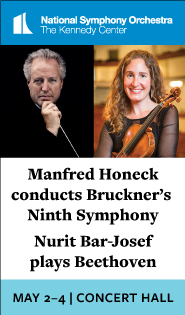Eschenbach is back with NSO in sunny Mendelssohn and rare Verdi

Christoph Eschenbach conducted the National Symphony Orchestra Thursday night.
Christoph Eschenbach became conductor laureate of the National Symphony Orchestra at the end of last season, when his successor as music director, Gianandrea Noseda, took the helm. In his new role Eschenbach continues to make periodic appearances with the NSO. This month he closes out the orchestra’s subscription season at the Kennedy Center with three programs featuring principal musicians in unusual concertos.
The first of the three programs, heard Thursday night, opened with a first for the NSO, the ballet music from Verdi’s Macbeth. Verdi added these three short pieces to the third act, set in the Witches’ Cave, for the 1865 performance at the Paris Opéra, two decades after the work’s premiere. The first of the pieces did not quite settle into place in this performance, with the trumpets unfocused in their dotted-note motif with the first trombone.
A melancholy solo shared between bassoon and cello was a highlight in the second piece, as were the cackling flute and piccolo lines and ominous four trombones in the final item. Although this performance felt not quite at ease, it was exciting to hear this music, which “departs considerably from Verdi’s earlier scores,” as scholar Andreas Giger put it.
Daniel Foster, appointed principal violist by Leonard Slatkin in 1995, took the solo part in William Walton’s gorgeous Viola Concerto, not heard from the NSO in twenty years. Foster excelled in the daring middle movement especially, his left hand precise through every cascading line. The NSO followed him supportively, negotiating all of the syncopated detours of this boisterous movement. In the first movement Foster’s intonation fitfully faltered.
His mellow tone smoldered most effectively in the low-set secondary theme and again in the more introspective parts of the third movement, as in the accompanied cadenza. In particular, he partnered beautifully against the gentle ostinato of the bass clarinet toward the end, as well as intertwining with the cello and harp (added by the composer in his 1962 revision). More spectacular color came in the cinematic sweep of the sections for full orchestra.
The NSO last played Mendelssohn’s Fourth Symphony, not very well, under Osmo Vänskä in 2014. Mendelssohn sketched the piece as he toured Italy, whence its nickname (“Italian”), and aimed for it to be “the jolliest piece I have ever done,” as he wrote in a letter.
Eschenbach drew a performance from his former band that was as warm and shimmering as a sunny day. In the first movement the tempo was active and quick, but Eschenbach avoided a too-frenetic pace. The brass and timpani added bright highlights to the generally unified sound of the strings and winds, one exposed horn squawk aside. Likewise in the second movement, the musicians found a speed that was solemn yet not lugubrious, perfect for the religious procession evoked by Mendelssohn. Eschenbach gave room for interesting countermelodies, especially in the flutes, to pop out of the texture.
The third movement was a genteel minuet, all refinement and restraint, which are not necessarily Eschenbach hallmarks. Impeccable playing from the horns, featured so prominently in the trio of this movement, erased any quibble against them in the first movement.
Everything about the finale, set at an extremely fast tempo, was impressively unified, especially the glittering flutes ornamenting the crisp, fluttering strings. A remembrance of spirited Neapolitan and Roman dances, this vivacious movement sent one out into the cool summer night with ears dazzled.
The program will be repeated 8 p.m. Saturday. kennedy-center.org; 202-467-4600.


